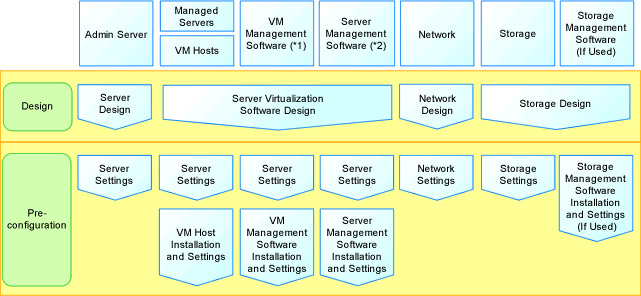This chapter explains the flow of Resource Orchestrator Design and Preconfiguration.
The flows for physical L-Servers and virtual L-Servers are different.
Figure 3.1 Design and Preconfiguration for Resource Orchestrator Installation (Physical L-Servers)

*1: When creating a physical L-Server using a blade server, installation of VIOM is necessary. When using rack mount servers that are supported by VIOM, installation of VIOM is necessary.
*2: Necessary when creating a physical L-Server using a rack mount or tower server.
*3: Necessary when using I/O virtualization using ISM.
*4: Necessary when using PXE boot in ISM.
Figure 3.2 Design and Preconfiguration for Resource Orchestrator Installation (Virtual L-Servers)

*1: When using VMware, Hyper-V, or OVM for x86 2.2, OVM for x86 3.x, server management software is necessary.
*2: When using Solaris Zones (Solaris 10) and OVM for SPARC, server management software is necessary.
Resource Orchestrator Setup Design
Design the following content when installing this product.
System Configuration Design
For details, refer to "Chapter 4 System Configuration Design".
Defining User Accounts
For details, refer to "Chapter 5 Defining User Accounts".
Defining Tenants and Resource Pools
For details, refer to "Chapter 6 Defining Tenants and Resource Pools".
When Using Converged Fabrics
Designing of tenants may be required because they are managed in a different way from the other network devices.
For details, refer to "H.1 Fujitsu PRIMERGY Converged Fabric Switch Blade (10 Gbps 18/8+2) and Fujitsu Converged Fabric Switch".
When Using IPCOM VX/VA
Designing of tenants may be required because they are managed in a different way from the other network devices.
For details, refer to "Appendix J IPCOM VX Series Devices".
Defining High Availability and Disaster Recovery
Refer to "Chapter 7 Defining High Availability and Disaster Recovery".
Defining the Server Environment
Define the server environment to manage with the admin server and this product.
For details, refer to "8.1 Defining the Server Environment".
Defining the Network Environment
For details, refer to "Chapter 9 Defining and Configuring the Network Environment".
Deciding the Storage Environment
For details, refer to "10.1 Deciding the Storage Environment".
Deciding Server Virtualization Software
Decide the server virtualization software to manage with this product.
For details, refer to "11.1 Deciding Server Virtualization Software".
Installing and Defining Single Sign-On
Deciding whether Single Sign-On is to be used, and its environment.
Refer to "Chapter 12 Configuring Single Sign-On".
Deciding the Power Monitoring Environment
For details, refer to "13.1 Deciding the Power Monitoring Environment".
Preconfiguration for a Resource Orchestrator Installation
Preconfiguration is necessary before the manager of this product is installed.
Perform it according to the following procedure.
Configuring the Server Environment
The server environment managed with the admin server and this product is set.
Refer to "8.2 Configuring the Server Environment".
Configuring the Network Environment
For details, refer to "Chapter 9 Defining and Configuring the Network Environment".
Configuring the Storage Environment
For details, refer to "10.2 Configuring the Storage Environment".
Settings for Server Virtualization Software
Set the server virtualization software managed with this product.
For details, refer to "11.2 Configuring Server Virtualization Software".
Configuring Single Sign-On
In order to use Single Sign-On, configure the Single Sign-On environment.
Refer to "Chapter 12 Configuring Single Sign-On".
Configuring the Power Monitoring Environment
For details, refer to "13.2 Configuring the Power Monitoring Environment".